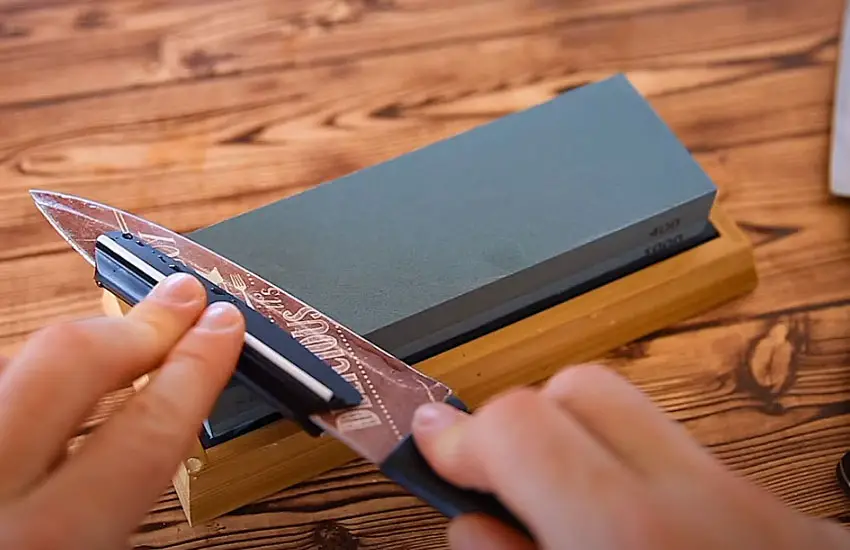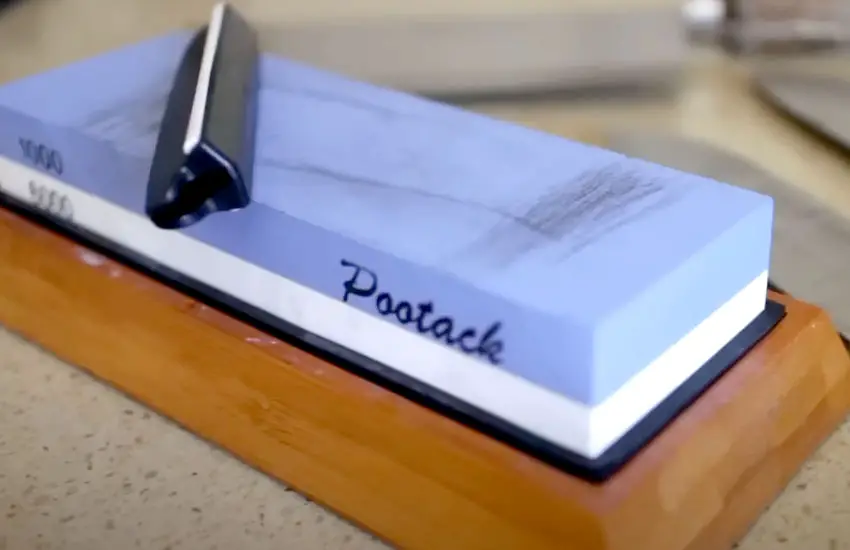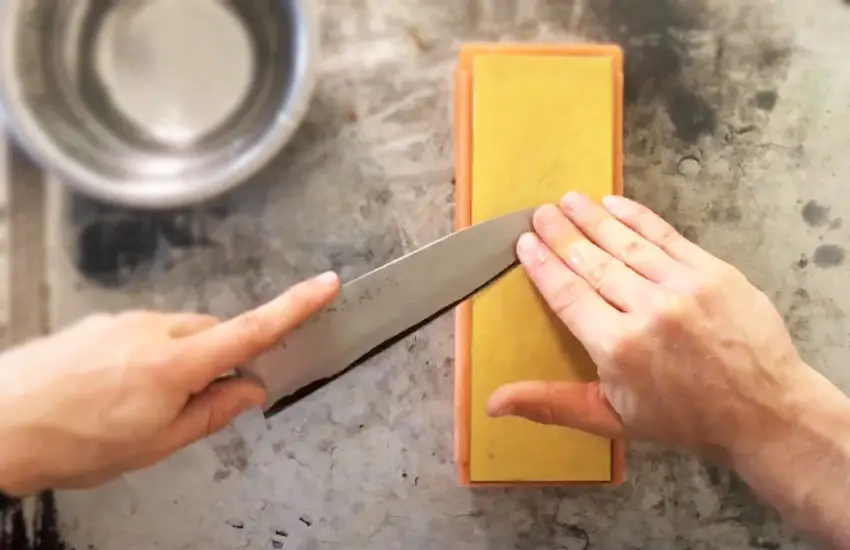As an Amazon Associate, I earn from qualifying purchases at no extra cost to you.
How to Sharpen a Bread Knife With a Whetstone: Expert Tips
If you’ve ever struggled with a dull bread knife, fear not – we’ve got a simple solution for you. In this quick guide, we’ll walk you through the easy steps to sharpen your bread knife using a whetstone. No need to be a kitchen wizard; all you need is a bit of time and the right technique.
A sharp bread knife makes slicing through your favorite loaf effortless and enjoyable. So, grab your whetstone, follow our straightforward instructions, and say goodbye to squashing your bread with a dull blade. Let’s get your bread knife back in top slicing shape!

Choosing The Right Whetstone
Choosing the right whetstone is crucial for maintaining the sharpness of your bread knife. Understanding different types of whetstones and selecting the appropriate grit are essential for the sharpening process. Let’s explore these factors in detail:
Understanding Different Types Of Whetstones
There are three main types of whetstones: oil stones, water stones, and diamond stones. Each type has unique properties and is suitable for specific sharpening tasks. Oil stones are lubricated with oil, while water stones require water for lubrication. Diamond stones, on the other hand, use diamond abrasives to sharpen blades.
Selecting The Appropriate Grit
When choosing a whetstone, the grit rating is an important consideration. Coarse grit (120-400) is ideal for repairing damaged or very blunt blades, while medium grit (700-2000) is suitable for regular sharpening. Fine grit (3000-8000) is used for polishing and refining the blade’s edge, resulting in a razor-sharp finish.

Preparing The Whetstone
Before sharpening your bread knife with a whetstone, it’s important to properly prepare the whetstone itself. This involves two key steps: soaking the whetstone and setting up a safe work area.
Soaking The Whetstone
To ensure optimal sharpening results, it’s crucial to soak the whetstone before use. Soaking softens the stone and prevents it from drying out during the sharpening process. Here’s how to do it:
- Fill a clean container with water.
- Submerge the whetstone completely in the water.
- Allow the stone to soak for at least 10-15 minutes.
- Once the soaking time is up, remove the stone from the water.
- Wipe off any excess water using a clean, dry cloth.
Important note: Some whetstones require longer soaking times, so be sure to check the manufacturer’s instructions for specific guidelines.
Setting Up A Safe Work Area
Creating a safe work area is essential to avoid accidents and ensure a smooth sharpening process. Here are some key steps to follow:
- Choose a well-lit and well-ventilated area for your work.
- Cover the work surface with a non-slip mat or towel to prevent the whetstone from sliding.
- Wear safety goggles to protect your eyes from any debris.
- Make sure your hands are dry and free from any oils or moisture.
Remember, safety should always be the top priority when handling sharp tools like knives.
Sharpening The Bread Knife

Proper Grip And Angle
Before you begin sharpening your bread knife, it’s important to achieve the proper grip and angle for optimal results. Hold the handle firmly with your dominant hand, ensuring a secure grip that gives you full control over the knife. Place your other hand on the blade’s spine, just above the handle, to guide your movements and provide stability.
When it comes to the angle, position the blade at a 20-degree angle to the whetstone for the best sharpening effect. This angle allows the knife to make proper contact with the stone, increasing the efficiency of the sharpening process.
Using The Whetstone In A Fluid Motion
Now that you have mastered the grip and angle, it’s time to put your whetstone to work. Remember, consistency is key to achieving a sharp blade, so maintain a fluid and consistent motion throughout the sharpening process.
Start by wetting the whetstone with water to create a smooth surface for the knife to glide over. Hold the knife’s blade against the stone at the desired angle, and with moderate pressure, move the blade back and forth along the stone’s surface.
Make sure to cover the entire length of the cutting edge in each stroke, from the base of the blade to the tip. This will ensure an even sharpening along the entire surface. Repeat this process for both sides of the blade until you achieve the desired sharpness.
Once you have sharpened your bread knife, rinse off any residue from the whetstone and the knife itself. Dry the knife thoroughly before using it again to avoid any accidents or damage.
By following these steps and maintaining the right grip, angle, and fluid motion, you’ll be able to enjoy effortless bread slicing with your newly sharpened knife. Remember, practice makes perfect, so don’t be discouraged if it takes a few tries to get the hang of it. Happy sharpening!
:max_bytes(150000):strip_icc()/__opt__aboutcom__coeus__resources__content_migration__serious_eats__seriouseats.com__images__20100423-sharpening20-2004-aba6e6fa129844a7a106fa006eb98c3d.jpg)
Credit: www.seriouseats.com
Testing And Finishing
Once you have honed the edge of the bread knife using the whetstone, it’s essential to test its sharpness before finishing up the process.
Checking For Sharpness
To check the sharpness of the knife, lightly run your thumb along the edge. If the blade bites into your thumb and grips it slightly, it indicates a sharp edge. Another way to test sharpness is to slice a piece of paper with the knife. A sharp knife will slice through the paper effortlessly, indicating that it is ready to use.
Honing The Knife Edge
After testing for sharpness, you can finish up the process by honing the knife edge. Move the blade smoothly across the whetstone, alternating sides with each stroke. Maintain a consistent angle of 15-20 degrees and employ gentle pressure. Repeat the honing process until the blade has achieved the desired sharpness.
Final Words
Mastering the art of sharpening a bread knife with a whetstone can immensely improve your kitchen experience. By following the step-by-step instructions and practicing regularly, you’ll ensure your knife stays sharp, making your slicing and dicing tasks effortless and precise.
With these skills, you’ll elevate your culinary prowess and enjoy the satisfaction of effortlessly slicing through any loaf of bread.
